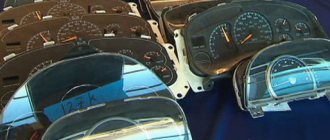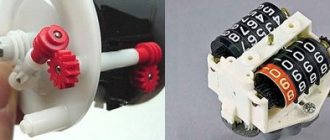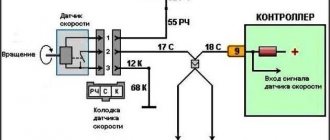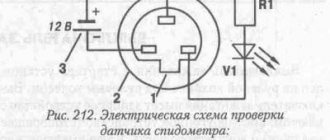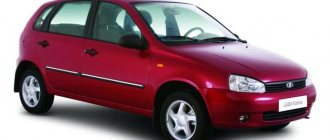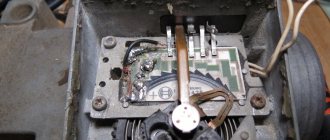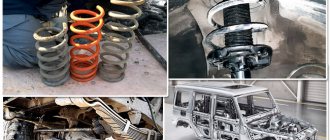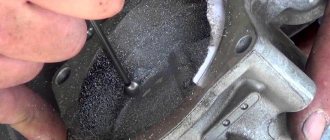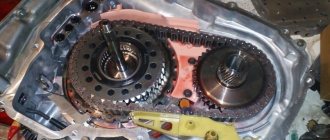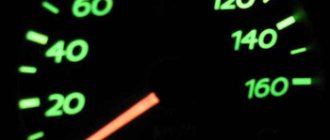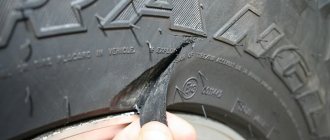A car consists of hundreds of parts and assemblies. This is a complex structure, each element of which has its own service life. It doesn’t matter what material a particular part is made of, during operation it is subject to wear, exhausting its safety margin.
The main criterion for determining the service life of car parts is its mileage - the length of the path traveled over the entire history of its use. The unit of measurement for the service life of car parts is “kilometers”. Before selling a car, many sellers have a question: how to wind the speedometer? This is what we will talk about.
Instructions for winding the odometer with your own hands
The reasons why drivers want to adjust the speedometer can be different. Those who want to sell a car at a better price are interested in how to rewind the speedometer. Knowledge of how to wind the meter is of interest to those drivers who cheat with fuel. Winding makes it possible to show more mileage and write off a larger volume of fuel than was consumed. The driver takes the difference for himself. Naturally, in this case, witnesses are not needed, so you need to be able to wind up the odometer on your own (the author of the video is Kanatbek Kuatbekov).
The need to calibrate the speedometer may arise if the instrument panel has been removed. In this case, correction is necessary to equalize operating conditions. Rewinding the speedometer is done when using discs with a diameter that does not comply with the manufacturer’s recommendations. If the diameter differs from the recommended one, then an error may occur in the odometer calculations, so the meter readings must be corrected.
Mechanical type
Winding up the speedometer, whose operation is based solely on mechanics, is very simple. In this case, you can rewind the counter in two ways. The simplest is to disconnect the cable from the speed sensor, the end attached to the box, attach it to the drill and turn it on in reverse mode.
Thanks to the rapid rotation of the drill, you can rewind the speedometer quite a bit in a short time. In the second method, you will have to dismantle and disassemble the instrument panel. After dismantling, the odometer is removed, on which the required mileage is set. These methods are suitable for most domestic vehicles.
Electromechanical device
Electromechanical speedometers, like their mechanical counterparts, are installed on older car models. But winding on them is more difficult than on mechanical counters. Winding and unwinding are different and require different approaches. To reduce the mileage on an electromechanical device, it will be necessary to dismantle and disassemble the instrument panel. To rewind the readings, the counter must be removed and the numbers manually adjusted.
The procedure for increasing mileage can only be performed using a generator. It generates signals arriving at the control input. Depending on the number of pulses, the readings of the device are adjusted (the author of the video is max gladkiy).
Electronic device
It is more difficult to twist an electronic device, since other devices are connected to the speedometer, which, like the speedometer, store information about the car’s mileage. These include sensors, a standard immobilizer, an ignition switch, a control unit and others. Therefore, to carry out winding, it will be necessary not only to send a signal from the controller, but also to reconfigure the corresponding devices. The information needs to be corrected for each device.
After changing the readings, you will need to reprogram the electronic board of the device. The microcircuit stores data on the daily mileage, as well as the total mileage during the operation of the car.
Why do they change the speedometer readings?
As already noted, drivers sometimes have to change the speedometer readings. In this case, the mileage is made both less and more. And if in the first case everything is clear - reducing the distance traveled when selling a car increases its price, then about the second it is necessary to make several explanations.
Rewinding the speedometer is possible for several reasons, for example:
- To increase fuel and lubricant costs. Higher mileage allows you to write off more fuel. And this is not necessarily associated with fraud and postscripts. The fact is that in an old, worn-out car, fuel consumption sometimes exceeds established standards. So you have to compensate for the increased costs in this way.
- When replacing the engine or instrument panel. In this case, it is necessary to bring the speedometer readings in accordance with the new conditions.
- When using discs other than those recommended by the manufacturer. Their diameter can be either larger or smaller than that specified for a standard wheel; therefore, when calculating the distance traveled, a constant error will occur. Here, winding the speedometer allows you to eliminate it, including doing it yourself.
Rewinding the electronic speedometer
For such a procedure, for example on UAZ cars, the following steps are provided:
- Remove the instrument panel and disconnect the speedometer wires and remove it.
- Pull the electric motor out of it;
- Using a screwdriver, rotate the gear to the desired reading on the speedometer;
- Insert the motor back and mount the speedometer in its place;
In fact, everything is much more complicated. To check mileage on an electronic speedometer, you will need scanners-readers and computer programs for them. With their help, it will be necessary to identify where the odometer records are saved (in which electronic units). Then reset this data from their memory. Using the coding function, adjust the speedometer readings and carry out adaptation.
- For “advanced” car owners, there are some devices - programmers, scanners, adapters. With the help of their special functions, you can successfully rewind the speedometer and erase all traces from the electronic memory.
- To reset the speedometer, it is necessary to reprogram the on-board computer through its connector, taking into account the supporting protocols. Also, they use a method of implanting a new microcircuit, which makes it possible to carry out, in the future, winding more than once.
- There is an option to replace contacts. It is applicable to car models in which the speed sensor is based on the Hall effect. There the phase on the speedometer changes with the phase on the tachometer, with the engine running. The method carries a risk of fire, so without certain skills, this should not be done.
- There is also a method using a special device - winding. This is a miniature and silent device that connects to the on-board computer connector. They have 3 wires. The speed sensor is disabled. Two winding wires are connected to the negative and positive ends, and the third is connected to the speedometer signal wire. This avoids circuit conflicts when the sensor is disconnected. Now let the winding work both while driving and when parked.
As can be seen from the above material, the procedure for winding up an electronic speedometer requires certain knowledge, and quite deep one at that. Mistakes in this matter will lead to numerous problems. Therefore, it is better to leave it to professionals. There are many different companies offering this service for a reasonable fee.
How to recognize deception
On a mechanical odometer, the numbers are located on special drums and click upward as the mileage increases, and they must be lined up exactly in one line.
If they are uneven, this is a sign of a twisted run. During correction, the numbers click in the reverse order and become crooked. You can inspect the speedometer cable attachment area to see if the fastening nut is unscrewed (it is better to ask someone who is well versed in cars). You can check the mileage on any odometer - both mechanical and electronic. Fortunately, you can recognize deception in both cases!
If the odometer is electronic, then the best option is to go for diagnostics to a service center at an authorized dealer. Signs of a twisted mileage should be looked for on the dashboard itself. It is necessary to check whether it was removed or not and whether there are traces of tampering on the electronic circuits. Electronic circuit boards of instrument panels are manufactured at the factory and covered with a layer of varnish; traces of tampering in the form of soldered chips, erased varnish or cleaned tracks can be seen with the naked eye.
Also, the mileage readings are recorded in the car’s on-board computer, and if the mileage is corrected, then traces of hacking remain, which can be detected by an electronics specialist at the brand’s proprietary service center.
The original mileage of cars from America and Canada can be found through the Carfax and Autochek databases. For Japanese brands, the mileage is indicated on the auction sheet (a document that is filled out by auction experts before putting the car up for auction, it indicates the condition of the car, equipment and options), but this is possible when the car was just delivered; during resale, the sheet may be “lost” "
The next step is to find the components for winding the run.
Mileage winding is in most cases a speed sensor simulator, i.e. the car seems to be moving at a certain speed.
In the store we will have to look for:
- AZ-2 or any similar device, this device was invented for carburetor cars, when their idle sensor failed so that they could continue driving. But in our time, when carburetors are reaching their end, they have found worthy use.
- The wires are about five meters long, 0.5 cross-section, the currents here are small;
- Plug into the cigarette lighter, you can do without it, but it’s more practical;
- Alligator clip for connecting to car wiring.
The diagram below shows how and which wires need to be soldered where:
Every city has an auto parts store that sells tuning parts, and most often you can find components there.
You must first connect to the line from the speed sensor, and then to the cigarette lighter. For a car, Gas on the electronic accelerator pedal is the green wire in the block next to the gas pedal. We make a neat cut with a knife in an inconspicuous place, exposing the wire so that we can hook the crocodile.
IMPORTANT! Do not rush to get upset if the speedometer needle lies flat after connecting, perhaps the car is in a position where the speed sensor hits the ground, so move the car forward or backward by 15 cm and the needle should rise. And also don't forget to turn on the ignition
When using this winding method, be extremely careful, because... the owner of the car may suspect that you are cheating, so I recommend not to be greedy, do everything evenly, and also reel in after the fact, i.e. every day, because so that a sudden check does not reveal any discrepancies between the waybill and the numbers on the speedometer. And if he finds out, it won’t hurt your pocket very much. Also, do not store the winding in a company car, because Your boss also has access to it; if he sees your device, he will definitely not envy you. And it’s not a bonus that will await you, but most likely a fine and a major audit.
When using this device, a drawback was identified: you need to leave the key in the ignition, which increases energy consumption. And it requires special control over the car, as it is susceptible to theft. Therefore, I suggest installing an adjustable time relay on the ignition. Those. so that we can set a timer and not be afraid for our car and the mileage.
Ps. : By the way, who is afraid to confuse plus with minus? In the AZ-1 and AZ-2 modules there is foolproof protection, i.e. If after inserting the plug into the cigarette lighter the light does not light, then swap the wires)))
Let's sum it up
You can twist the mileage quite simply. This process is not difficult at all. It is enough to determine what readings on the odometer you want to see. It does not matter whether we are talking about a mechanical or electronic speedometer. The essence will always be the same. But it is worth remembering that mileage cheating is actually a crime for which compensation can be demanded through the court or the transaction can be canceled without any problems. Then you will have to return the money for the car and endure the most unpleasant moments after the sale. In most cases, cheating mileage does not pay for itself; it is better not to engage in such deception.
It must be said that in European countries it is not customary to inflate mileage, but in the CIS, every third seller on the market does this. Therefore, mileage has long ceased to be a determining factor in purchasing a car. Most likely, you will not be able to obtain certain benefits from rolling up the odometer readings. However, until twisting tools are blocked by manufacturers, our car sellers will actively use these tools. Have you ever checked the mileage of a car before selling it?
What does a speedometer measure?
What does the speedometer measure? If you delve into the name, speed is speed (English), and meter (we won’t burden you with the Greek alphabet) is measure (Greek), which almost literally speaks of the measurement of speed with this device. And this device is already many years old. Its debut was in 1901 on the Oldsmobile. And the patent was received by Nikola Tesla only 15 years later. Although there is information that the verstomer, an invention of the self-taught serf mechanic Yegor Grigorievich Kuznetsov, was created in the 18th century. It was installed on mechanical tracks. The arrows of the verstomer showed the distance traveled, and the bell measured each verst with its ringing. The invention can be viewed in the Hermitage in St. Petersburg. Over the past century, the average person has been shown many different modifications of the device, both in the type of information provided and in the method of measuring it. Pointer and digital instruments are the most common today; graphic panels have appeared, like a laptop monitor. Older people may remember the tape speedometer, like on the GAZ-24 before 1975. On pre-war cars there were often drum ones, where the speed values were marked on the drum, which, when rotating, showed them in the window. Now you can see this on Citroen. There are also many options for measuring speed. They can be divided into groups:
- Mechanical speedometers (centrifugal, chronometric, vibration);
- Electromechanical (electromagnetic, induction) and electronic.
There are devices that determine speed through a satellite positioning system (GPS or GLONASS). However, a GPS speedometer for a car is more of an option that increases driver convenience. They are not installed standard from the factory.
About mileage spinners.
If something is already more or less clear with correction, then twisting is a separate area. On electronic speedometers without system data buses, everything was implemented by the same speed sensor emulator. They are popularly called Krutilki, Motalka, Podkrutka, all this is a pulse generator. The most optimal generator circuit for tweaking speedometers is obtained using an integrated timer 555. It does not need a voltage stabilizer, it is powered by 5-18 volts, it includes an output switch with an open collector and a current of up to 100 mA. Everything changed with the introduction of digital data buses into the auto industry. Nowadays, in cars with an ABS system, speed sensors are no longer installed, but the speed is taken from the ABS wheel sensors. The ABS module is connected to the CAN digital data bus, to which other vehicle modules (engine ECU, Speedometer, etc.) are also connected. The mileage specialists grabbed their heads. Emulating wheel sensors is very troublesome and needs to be done individually for each car. ABS swears at every little thing and produces a bunch of errors. Interfering with a critical part of the wiring is also a very bad step. But there was no other way out. But it is clear to everyone that winding through ABS is not an option, but it was used until another way to tighten the speedometer appeared. A new way of winding is to use a new generation of mileage winders that work directly with the car’s digital data bus itself. The point is that the mileage adjustment device will intercept messages with speed data and send its own at the required speed to add the mileage on the speedometer. Advantages of CAN winding devices: Small size. Low cost. Ease of use. The mileage is displayed not only in the speedometer, but also in other electronic modules. The car completely and truly thinks it is moving. And there are no electronic errors. On many cars (TOYOTA, FORD, NISSAN, INFINITI, LEXUS, RENAULT, SsangYong, Chevrolet), the CAN bus of the power plant is directly connected to the diagnostic connector. In such cars there is no need to install and connect the speedometer at all (yes, it’s just a miracle speedometer twister). Disadvantages of CAN winders: Each (almost every) car model has its own format and encoding of speed data. On some cars (Mercedes, Audi, VW, Skoda) it is necessary to connect the bus to the diagnostic connector or connect an additional 4-pin connector (whichever is more convenient for you). We have developed a speedometer screw circuit that is cost-effective and highly reliable. Thus, we can offer the cheapest Krutilki in Russia. We are also developing a network of representatives in different cities. If speedometers are your business, join our affiliate network. Our representatives receive an even lower cost of twisters, and an additional procedure for resetting the mileage limit as an additional source of income. It’s easy to become a representative, just buy a total of 5 spinners. Especially for our representatives, we have developed odometer checkers (All in one), which can change mileage on different cars.
Types of speedometers
A speedometer is a device that shows how fast a car is moving. An odometer is a device that measures mileage traveled. Both meters are located on the instrument panel.
There are the following types of speedometers:
- Mechanical. These are the first devices that began to be installed on cars. They are based on a mechanical drive. Using a small cable, the gearbox revolutions are transmitted to a counter, the wheels spin, and the speed readings are reflected on the panel. The number of revolutions on the odometer shows the mileage.
- Chronometric. They combine an odometer and a clock device.
- Centrifugal. The device is based on centrifugal force. It acts on the meter arm, displacing it a certain distance. The regulator rotates with the spindle, so the distance by which the arm is shifted is equal to the speed of movement.
- Vibrating. It is used with fast-rotating mechanisms. The graduated tabs are mechanically acted upon by the frame or bearings. The vibration frequency depends on the speed of the vehicle.
- Induction. Its design includes a disk made of copper or aluminum, a system of permanent magnets, and a spindle. The disk is directly attached to the arrow indicating the speed.
- Electromechanical. They are an improved version of a mechanical device. Their design is complemented by a special speed controller. It transmits signals to an electric motor, which rotates the rotor. This is where the devices differ from each other, but otherwise they are similar.
- Electronic. The counter measures the number of revolutions of the wheel itself. The device analyzes the circumference of the wheel, based on the data obtained and the number of revolutions the wheels have made, the number of kilometers traveled is calculated. The received information is reflected on the LCD monitor.
- Speedometers that determine speed using a GPS navigation system.
Mechanical speedometers are gradually being replaced by electronic analogues. Electronic speedometers are most often installed on modern vehicles. Mechanical devices are found on old-style vehicles.
How to wind the speedometer on a KamAZ
The KamAZ-6520 or KamAZ Euro speedometer is adjusted using special devices that allow you to adjust the device’s performance. If you need to rewind the device or change the device data, you can contact specialists. But there is a way to do it yourself.
KamAZ is equipped with a speedometer and odometer, showing the mileage of the vehicle, and has a generator and engine system. The generator is the sensor, the engine is the receiver. The speedometer receives a three-phase signal from the generator.
The winding circuit of the device should create a similar three-phase signal with a 120° shift between phases. To change the data on the number of kilometers, you need to change the numbers not only on the speedometer, but also on the odometer. A device for winding measuring devices (twist, winder or winder) carries out such actions automatically. When twisting, the changed data of the electronic speedometer and all other electronic units are saved.
How to increase mileage?
Many car enthusiasts, even those who need to increase mileage for objective reasons, often refuse this procedure to the detriment of their own interests, although in fact, increasing mileage is absolutely safe for the car’s electronic systems.
You can wind the speedometer using a special device called a “winder”. The device is intended for calculating electronic speedometer readings on cars manufactured after 2006. Although if the car has an earlier year of manufacture, you can also choose a device to change the mileage.
Instruments and devices for winding
If you don’t know how to rewind your mileage, but don’t want to go to a car service center, you can purchase a special device with which you can rewind the speedometer. There is a wide selection of mechanisms available on the market, which makes it possible to choose a device suitable for a particular car. These devices are easy to use, so any car enthusiast can adjust the speedometer. There are different options for speedometer winders, which differ in design and operating principle.
CAN twister
Speedometer corrector via digital CAN bus, used for modern cars equipped with a control unit. Through the CAN bus, blocks of electronic devices exchange impulses with each other. Before tightening the speedometer, the CAN twister must be inserted into the OBD diagnostic connector. It is located within the driver's reach, usually near the steering column. Thanks to exchange protocols, this connector allows you to access electronic devices.
Thus, using CAN knobs, you can adjust the necessary memory cells in the control unit to set the desired mileage. These devices are popular among dealers of used cars. They use them to twist the speedometer to reduce mileage. It is almost impossible to detect that changes have been made to memory cells, even with the use of modern equipment.
Pulse
The pulse speedometer corrector is used on imported cars that are equipped with a digital CAN bus. To use the device, you must insert it into the OBDII diagnostic connector located near the driver’s feet. Pulse winding of the speedometer sends impulses to the odometer, which are imitation of signals from the speed controller. With its help you can change the mileage readings.
Speed generator
A speed generator is a device that allows you to increase the mileage traveled by your car on its own. The device can be used on foreign cars manufactured before 2012. A special feature of these cars is that the speed signal does not come through the digital CA bus, but in the form of pulses.
The generator is connected to the OBDII diagnostic connector. It simulates the transmission of impulses that are received when a car moves. Using the device you can correct the odometer readings.
Other options
A universal device for winding up a speedometer is winding up a speedometer using a phone charger. The device is inserted into the cigarette lighter. The wire coming from the device is connected to the wiring using a female-male connector. This device can be used on both imported and domestic cars. To install it you do not need to have any special knowledge. The device comes with instructions for connection and use.
You can twist the speedometer using ABS twisters. This option can be used on cars that have an anti-lock braking system. The device uses a speed sensor and wheel rotation. When the device is connected to the desired connector, it begins to simulate the rotation of the wheels, according to which the sensor corrects the mileage readings on the odometer.
There is also a standard device for rewinding the speedometer. The speedometer corrector is turned on and off using a button located on its body. The device is equipped with a speed controller, so you can adjust the speed as you wish. The speedometer winding diagram for installation is included in the kit.
It is quite difficult to check the mileage on a modern car, which has a large number of electronics installed. But special devices allow you to change odometer readings without specialized knowledge.
Ways to change speedometer readings
Despite the fact that the years that were accompanied by a total shortage have passed, nowadays it is now possible to purchase any auto part without difficulty, the habit of “embellishing” the condition of the vehicle has remained with car owners.
Car manufacturers have abandoned mechanical speedometers, equipping modern cars with electronic devices in order to somehow try to eradicate this addiction to deception, but it is completely impossible to stop it. Many people still strive to increase the speedometer mileage.
How to change the mechanical speedometer readings
Mechanical speedometers often accompanied technical means until the turn of the 20th and 21st centuries. Although some domestic cars continued to be equipped with them even before 2007.
Due to the fact that mechanical speedometers are simple devices, even an inexperienced car enthusiast can twist the speedometer himself, who will first familiarize himself with the advice of experienced craftsmen.
Initially, the speedometer is removed and connected to a motor, after starting which the mileage will automatically increase or decrease. By the way, some car owners, indeed, not only reduce the mileage, but also increase it, on the contrary, thereby convincing the buyer that a vehicle with a certain mileage has already successfully passed maintenance and therefore does not need repairs.
When removing the speedometer, it is impossible not to break the seal, so this trick may not work for all purchasers. Although some brands of cars are accompanied by fastening the speedometer in such a way that does not require its complete removal, it is enough to disconnect only the drive cable.
When trying to twist the speedometer, it is not recommended to rush, since the numbers will not be located on the same line when the motor is running quickly, giving away tricks of manipulation to the buyer.
How to change electromechanical and electronic speedometer readings
Electromechanical speedometers replaced mechanical ones in the eighties, but lasted until about 2008. The drive cables in them were replaced with electrical wires.
https://youtube.com/watch?v=a2_qSm-SXeE
Manufacturers installed special indicators in the gearbox that read pulses from the rotating modulator.
It is possible to twist an electromechanical speedometer using a special pulse generator, although some craftsmen manage to perform such work using an electric motor on which the modulator is directly installed.
Modern cars are already equipped with electronic speedometers, since manufacturers are interested in a serious degree of protection. Owners of modern technical equipment who want to know how to twist an electronic speedometer can get advice on this issue from experienced craftsmen, but one cannot hope for an easy solution to the problem.
In most cases, you cannot reduce or increase mileage yourself, so you have to turn to specialists
Unfortunately, this type of service is accompanied by a considerable cost, so it is important to weigh the feasibility of such actions
And yet, if someone really wants to know how to twist an electronic speedometer, the craftsmen can reveal the secret that all actions are accompanied by the use of computer equipment, in particular, a special programmer that connects directly to a microcircuit containing information about the car’s mileage.
Having ensured such a connection, the programmer manually enters the necessary parameters, changing the mileage of the car. You can check the mileage by connecting the computer to the diagnostic socket. The advantage of this method is that there is no need to remove the instrument panel. However, the disadvantage indicates that it is extremely difficult to have the appropriate software that allows such manipulations, since it is only available from the manufacturer or official dealer, who value the prestige of the company and are unlikely to want to distribute the software to everyone.
So, adjusting the speedometer indicator is a real relic of the past, which has confidently and firmly penetrated modern life and is not going to lose ground, allowing owners to “cunningly” but profitably sell their cars.
What types of speedometers are there?
To understand how to wind a speedometer, you first need to understand the operation and types of the device itself.
A speedometer is an accurate metric instrument that measures the instantaneous speed of movement. One of the very first simple speedometers, invented and patented by Nikolo Tesla at the beginning of the last century.
It's hard to believe, but there are 11 types of this device.
- By measurement method:
- Electronic
- Induction
- Electromagnetic
- Vibrating
- Centrifugal
- Chronometric
- Positional – focused on satellite navigation
- According to indication;
Analog:
— Switch
— Tape
— Drums
Digital
We will not dwell long on the description of all these species (this is a separate topic). It should only be noted that digital devices have not taken root in the design of cars. The fact is that the numbers on the scoreboard changed too often (after all, the speed is measured every moment). The driver could not follow these changes and accurately determine the average speed. Experts tried to slow down the display, but this greatly distorted the data during braking and acceleration. Due to such circumstances, the manufacturer returned analogue, dial speedometers to the design.
In conventional car speedometers, another measuring device is built in - an odometer. So it measures mileage (in kilometers or miles). In addition, there is also a daily mileage counter, with a special mileage reset button (the official “rewind” of the speedometer).
Like all measuring instruments, the speedometer has an acceptable error. As a rule, deviations in car speedometers occur in the direction of increasing speed. It is measured not in kilometers, but as a percentage.
Why shouldn’t you have a negative attitude towards increasing mileage?
Most car enthusiasts have a biased opinion towards those who decide to wind up the odometer. The fact is that unscrupulous sellers resort to rolling up the odometer, wanting to hide the true mileage in order to sell a used car at a higher price.
But it is worth noting that the mileage is reduced not only in the direction of decrease. There are objective situations that require increasing mileage:
- • The need to undergo maintenance at a service center ahead of schedule, for example, before a long trip.
- • Replacement of the instrument panel, resulting in a failure of the odometer readings.
- • The need to adjust mileage due to engine replacement.
- • Installation of wheels of non-standard diameter, due to which the actual mileage does not correspond to the actual one.
- • Fair compensation for fuel costs.
Of course, there are times when you need to reduce your mileage. Indeed, for a careful owner, the excellent condition of the car does not always correspond to the true mileage, which is especially upsetting during the sale, when the buyer, seeing an impressive number on the speedometer, demands to lower the price. In this case, it is enough to simply check the mileage if the otherwise good technical condition of the car does not reveal its real age.
Electronic speedometer
Almost every modern car is equipped with an electronic speedometer. Perhaps after a certain time it will completely replace mechanical analogues, but for now they are still present even in new models. The operating principle of the electronic device is simpler than that of a mechanical speedometer.
Often, an electronic device has a magnet in its device, which is attached to the output shaft of the gearbox. The magnet rotates with the shaft, and an electronic unit is located nearby. At the same time, rotating in a circle on the gearbox shaft, the magnet periodically passes in close proximity to the electronics, transmitting a signal to it and thereby performing the function of a sensor.
And every time the magnet passes by the block, it sends an impulse to the speedometer. Inside the meter there is a so-called black box (notable for its increased intelligence), which calculates the speed using these impulses. To wind the speedometer, this knowledge will not hurt.
There is nothing easier to understand: the faster the pulse transmission frequency, the faster the box shaft rotates. All calculations are performed with maximum accuracy and have almost zero error.
Errors
It happens that metering devices record the wrong speed of the car. On the one hand, it’s even good when the speedometer shows slightly increased readings. In this case, the driver will comply with the speed limit and will not receive a fine. And manufacturers are calm, and drivers do not violate traffic rules.
Why do errors happen? The fact is that this device is not highly accurate, since the rotation of the car wheel is mainly used to determine speed. In this case, its diameter is taken into account, and this parameter is not stable. This is important to know when deciding how to wind an electronic or mechanical speedometer.
Speedometers on many modern cars have an average error of 10% at a speed of 200 km/h. But the dependence is nonlinear. That is, at a speed of 110 km/h the difference from the real one can be 5-10 km/h. But if you drive slower (up to 60 km/h), then the error is so small that it cannot be felt.
Speedometer and odometer
Everyone knows perfectly well what a speedometer is. This is a device that shows the speed of the car at any given moment in time. But there is also such a thing as an odometer. Someone has already heard this term and knows what it is about, but not everyone is able to understand what kind of device it is. Meanwhile, it serves to measure the distance traveled by the car.
In fact, the speedometer is a combined device that combines a speed meter and a mileage meter from the date of release. Some cars, in addition to the odometer, have another device - a daily mileage counter. To reset it, a special button is provided (something like rewinding a speedometer).
Psychology
On the market and various websites, you often come across advertisements for the sale of cars that are 5-7 years old with mileage from 30 to 70 thousand kilometers. Somehow this doesn’t really agree with the Autostat data. The discrepancy is explained simply - for more than half of used cars, the mileage is simply adjusted to psychologically comfortable levels. In other words, just twisted.
By the way, if not half of car owners, then a good third for some reason believe that the “thing” where the mileage numbers are shown is called a speedometer. Like, he alone is responsible for both speed and mileage. In fact, the odometer is responsible for the mileage. Let's talk about him.
How to wind the speedometer yourself
Well, with a mechanical speedometer, as described above, everything is quite simple. You need to disconnect the cable of the device from the gearbox and attach it to the shaft of a small electric motor or to a drill. Select the direction of rotation and twist. It will take a long time to turn, because the gear ratio in the gearbox is high. In principle, the concept of “twisting the speedometer” came from this “old-fashioned” method. There is a second option... You need to remove the odometer and, using a special tool and brute force, set the required values. The electromechanical trip meter is a little more complicated.
If you need to reduce mileage, you can only use “handles” to set the value on the odometer wheels and disassemble it. If the mileage needs to be “rewinded”, then you cannot do without a pulse generator.
If you need to “wind up” kilometers, then there is a simpler solution. There is a “Twister…” or “Speedometer Rewind” device. You can buy a “Rewind” electronic speedometer on the Internet in a couple of mouse clicks.
In principle, mileage as such may not always reflect the actual technical condition of the car. You can drive 50 thousand kilometers in a year, while driving carefully and regularly carrying out maintenance. And you can “kill” a car for 10 thousand. Therefore, if you want to purchase a new iron horse, do not put mileage at the forefront
Inspect the entire car carefully. If you nevertheless decide to adjust the odometer readings, approach this issue carefully. Don't chase low prices, find out more about the specialist
Find out if he has experience, what equipment he works with, what guarantees he gives. There are a lot of offers on the market. You decide.
Cost of work to correct readings
Many people today are wondering, how much does it cost to correct the speedometer readings? As with any work, it all depends on its volume and complexity. If with a mechanical speedometer everything is quite simple, you just need to turn its drive in the right direction, if only you have free time, then with modern systems everything is much more complicated. This requires knowledge not only of automotive electronics, but sometimes even the qualifications of a programmer. In the first electronic speedometers, mileage data was recorded in the device’s memory and changing them was not very difficult. Now manufacturers duplicate this information in various electronic units (engine control unit, brake system control unit, immobilizer unit). In addition, this data can be encrypted.
About types of speedometers
Before figuring out how you can change the readings of such a device with your own hands, you need to consider its possible options. There are several fundamentally different types of speedometers:
- mechanical;
- electromechanical;
- electronic.
Mechanical speedometer
The gearbox speed is transmitted directly to the device by a cable. There the number of revolutions is measured and converted into the distance traveled. For this, a gearbox with a pre-selected conversion coefficient is used. The photo will help you understand how this is done.
In fact, it turns out that one revolution at the output of the gearbox corresponds to a certain number of meters of the distance traveled. This rotation of the output shaft is perceived by special disks (indicating device) with printed numbers displaying the measured distance.
Electromechanical speedometer
This type of device is a further development of the previously described device. In many cases the cable was the source of increased error and was replaced. A speed sensor installed on the gearbox was inserted into the device. Impulses from it were sent to a motor with appropriate control that rotated the gearbox. Otherwise, the operation of such a speedometer was no different from a mechanical one, resembling it in appearance.
Electronic speedometer
A similar type is installed on modern cars. In this case, the number of wheel revolutions is measured. Knowing the length of its circumference, it is not difficult to convert the number of revolutions into the distance traveled. The result obtained is displayed on the LCD.
Why shouldn’t you have a negative attitude towards increasing mileage?
Most car enthusiasts have a biased opinion towards those who decide to wind up the odometer. The fact is that unscrupulous sellers resort to rolling up the odometer, wanting to hide the true mileage in order to sell a used car at a higher price.
But it is worth noting that the mileage is reduced not only in the direction of decrease. There are objective situations that require increasing mileage:
- • The need to undergo maintenance at a service center ahead of schedule, for example, before a long trip.
- • Replacement of the instrument panel, resulting in a failure of the odometer readings.
- • The need to adjust mileage due to engine replacement.
- • Installation of wheels of non-standard diameter, due to which the actual mileage does not correspond to the actual one.
- • Fair compensation for fuel costs.
Of course, there are times when you need to reduce your mileage. Indeed, for a careful owner, the excellent condition of the car does not always correspond to the true mileage, which is especially upsetting during the sale, when the buyer, seeing an impressive number on the speedometer, demands to lower the price. In this case, it is enough to simply check the mileage if the otherwise good technical condition of the car does not reveal its real age.
Possible device malfunctions
Why doesn't the speedometer work?
There are many reasons, let’s look at the main ones:
- The device does not work. The problem is unscrewing the nuts that connect the flexible pulley to the device and transmission, if this is the case, then they just need to be tightened. A non-working device may be the result of a broken cable; if this is the case, it will have to be replaced. In some cases, the device roller jams in Gazelles, then there is nothing left to do but replace the entire device.
- The needle on the scale begins to fluctuate, and extraneous sounds may appear. Initially install the device shaft, and the bend radius of the cable must be at least 1.5 cm. If the reason is that the flexible pulley is loosely attached to the device or transmission, the fixing nuts must be tightened completely. If there is no lubricant on the cable, it must be added. If there is dirt where the cable is installed on the transmission, this may cause the needle to wobble, so the dirt should be removed.
- The adjustment of the instrument needle is incorrect - another type of malfunction. If the cable is installed incorrectly in the casing of the flexible shaft, it must be reinstalled there. Please note that the thrust bushing B must be located on the transmission side.
- The arrow of the device has hit the limiter and does not rise higher; this may be a consequence of a broken spiral spring; the only option is a complete replacement.
Device for rewinding odometer readings
Important elements of the dashboard
The main place on any dashboard is occupied by a speedometer with an integrated odometer - a sensor indicating the mileage of the car.
A speedometer is needed for a car to control the speed limit and follow traffic rules on road sections with limited speeds.
The odometer integrated into the speedometer usually shows two values - a certain mileage, which can be daily, mileage from refueling to refueling, etc. This value can always be reset, and the countdown will start again.
The second value that the odometer shows is the total mileage of the car.
This sensor is more important than the readings, which can be reset at any time.
Based on its readings, the necessary maintenance is carried out.
The frequency of a particular service is always indicated in the technical documentation that comes with the car, and this frequency is expressed in the total mileage of the car, which is precisely what the odometer shows.
Previously, mechanical odometers with a cable drive from the gearbox were installed on cars.
Nowadays, electronic devices are more common, displaying mileage information on a small display.
The data displayed on the display is indicated by the electronic control unit, based on the readings of certain sensors.
Despite its small size, the odometer has a rather complex design, so it is quite possible for it to fail.
Problems, for example, may arise with the instrument panel itself, as a result of which the instrument readings will be incorrect or will not be displayed at all.
In this case, the odometer reading will need to be adjusted.
It should be noted that dishonest car owners often use the correction of such readings before selling their car. They simply rewind the readings downward.
What to do if the speedometer and tachometer stop working
Speedometer winder
Demand creates supply. This law applies everywhere in the modern market. It was with the advent of the need to increase mileage that some manufacturers of automotive electrical equipment thought of inventing and making a device for increasing mileage, in common parlance - a winder.
Diagnostic connector of the editorial machine. Located in the glove compartment. On the first Logan, the connector is located in the same place.
This device is connected quite easily, since you just need to insert it into the OBD-II connector or, in simple terms, to connect diagnostic equipment to the brains of the car. But, as practice shows, not everything is as simple as it seems in reality.
At the first stages, motorists encountered a problem when the device actually accumulated mileage. But at the same time, the real one remained in the ECU itself, and when checking the parameters, the numbers did not match.
What should a driver do to increase mileage without consequences? More on this below.
- Remove part of the instrument panel and remove the instrument cluster.
- Next, we disassemble the OBD II connector, which is located in the glove compartment.
Location of the diagnostic connectorLocation of OBD 2 wires
Reasons for mileage twisting
The electronic meter stopped counting mileage
There are quite a lot of people today who want to correct their car's mileage readings. And everyone justifies their desire differently. This includes a malfunction of the speedometer, replacement of the instrument panel, and driving on non-standard tires. Although, to be honest, the main justification for such actions is the desire to prolong the youth of your four-wheeled friend, perhaps for the purpose of subsequent sale. Selling a car with lower mileage is easier and more enjoyable to buy. Both the seller and the buyer are satisfied. By the way, when driving on non-standard tires, calibrating the speedometer will help solve the problem for a long time. And you won't need to regularly reduce your mileage. There are also those who want to increase their mileage. Mainly on commercial vehicles, or if the car is used for business purposes. This is also understandable in its own way. Often, the fuel consumption standards calculated by accounting departments do not cover the actual costs of gasoline. On the contrary, compensation for the use of personal transport only covers refueling, without taking into account depreciation and wear and tear of equipment. In an attempt to compensate for these costs, drivers resort to cunning and increase their mileage.
Winding up a mechanical speedometer
Prices for such a service in auto repair shops vary greatly. Mechanical speedometers are easier and cheaper to wind up. But you will have to tinker with electronic devices, and the prices from specialists are very high. There are car brands for which the cost of such a procedure reaches 25,000 rubles.
The fact is that in modern electronic systems, information from the odometer is duplicated in different systems, in encoded form. Previously, it was recorded only in the memory of the device itself. It was enough to erase this data only from the device’s memory. Now, in order to adjust the speedometer, you need to correct the data in many electronic units.
A mechanical speedometer is wound up like this:
- Disconnect the cable from the gearbox;
- Attach an electric drill to it using a rubber pipe. Pull one end onto the tip of the speedometer cable, insert the other into the chuck of an electric drill;
- Plug the cord into a power outlet. As the needle rotates, the speedometer readings will decrease. Wait a little until the readings reach the desired level, turn off the drill;
- To put everything back in place, follow the same steps in reverse.
Cost calculation
For many, price is a fundamental factor in almost everything: purchases, services, and so on. In this connection, it is reasonable to ask yourself the question of how much it will cost to adjust the speedometer, which is so necessary in some cases. Here, as with any work in a car repair shop, everything depends on the complexity of its implementation and volume.
It’s not so difficult to tinker with mechanical speedometers; all you need to do is rotate the mechanism drive in a certain direction. If there is time, the desire will always be there. However, with electronic metering devices everything is much more complicated than it might seem. Basic knowledge of vehicle electrical equipment is required here. And in some cases, you cannot do without the knowledge and skills of a programmer.
Currently, in many stores that have their own website, you can purchase a speedometer winder with adjustable winding speed. There are different options on sale, and any car owner will get what they want.
To carry out the procedure correctly, it is necessary to edit the data wherever it is. This significantly complicates the matter; moreover, it is necessary not to affect important indicators of other systems. If you turn to a non-professional, you should prepare to buy any new part, perhaps more than one. In addition, the work itself will not be cheap.
As for the cost of a competent adjustment, prices vary significantly and depend not only on the make of the car, but also on the year of production. For example, for a UAZ Patriot car the price can start from 1,500 rubles. Owners of a new Land Rover car will have to fork out 15,000 rubles. There are companies where the price for such work can reach 25,000 rubles. It may be worth purchasing a speedometer winding circuit with adjustable winding speed and doing everything yourself.
What devices are used to wind electronic speedometers?
Considering the variety of cars available and methods for processing data from the speedometer, several different options have been created that allow you to correct the distance traveled. The circuit of such a device can be made both on discrete elements and on microprocessor systems, but all finished products are divided into the following types:
CAN twister
This device is designed for use on modern machines. Here you need to know that CAN is a special bus through which data is exchanged between car electronics units. And its design implies the presence of a diagnostic connector, through which, knowing the exchange protocol, you can gain access to individual devices.
Accordingly, thanks to this, you can adjust the contents of the necessary memory cells, achieving the desired result. It is impossible to detect with diagnostic equipment that memory cells have been changed.
You can buy a high-quality spinner on the website https://can-podmotka.ru
Pulse twister for OBDII
This device is intended for use with foreign cars that do not have a CAN bus. This device is connected via a special OBDII diagnostic connector. In this case, the speedometer receives a sequence of pulses simulating signals from the speed sensor, as a result of which the readings of the distance traveled change.
Speed generator
This circuit simulates a speed sensor. Instead, the generator turns on and produces a sequence of pulses that arrive at the speedometer and cause its readings to change. Mostly suitable for electromechanical devices and domestic cars - VAZ, UAZ and others manufactured before 2006.
ABS speedometer knob
Suitable for cars equipped with ABS. Its work is based on controlling the speed and rotation of the wheel. A spinner connected to the corresponding connector simulates the operation of the wheels, and the controller, receiving this information, begins to change the speedometer readings.
You can make a winding device yourself or buy a ready-made one, but the most important thing is to determine whether it can be used on a given machine. If used incorrectly, you can simply burn the electronics.
As strange as it may seem, sometimes it becomes more important not to twist the speedometer, but, on the contrary, to wind it up. There are a number of reasons, both objective and subjective, that force one to do this. More than one device has been created that allows you to solve the problem, and you can choose a device that takes into account the production date of a particular car and allows you to carry out this procedure without consequences.
I like4I don't like1
The distinctive advantages of the device for winding up the speedometer can be considered:
- • The device does not require special installation.
- • Connects via a diagnostic connector directly inside the car.
- • Any car owner can use the speedometer winder, since the device is easy to operate.
- • The spinner has a compact size, so it can even be stored in the glove compartment.
- • High winding speed of the speedometer can reach 5 thousand kilometers per hour.
- • The device is suitable for any brand of modern car, regardless of engine size or gearbox type.
- • Winding changes the mileage readings simultaneously in each duplicate block.
